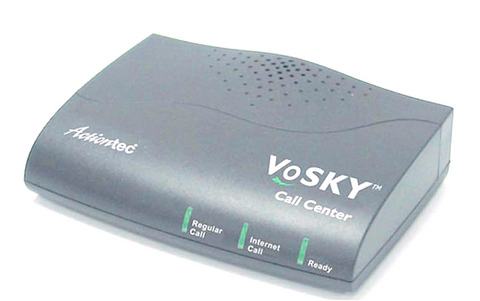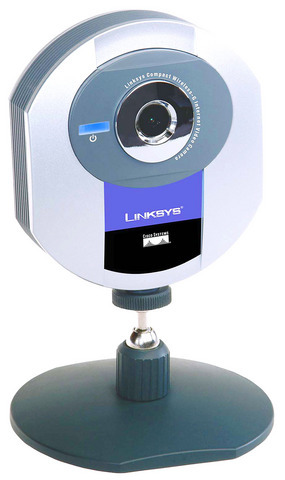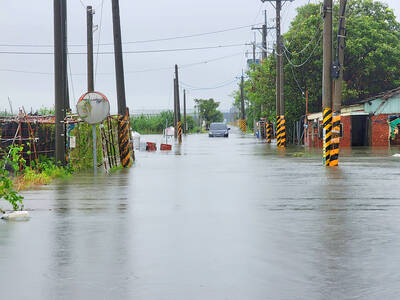Webcams have long been tethered to PCs and laptops. The Linksys WVC54GC is a free agent, however, connecting to wireless networks and transmitting video and audio to Web browsers anywhere in the world.
This small camera uses the 802.11g Wi-Fi standard to send 320-by-240-pixel color video over the Internet. Linksys offers a service called SoloLink, which supplies a password-protected Web page to allow remote viewing and to let the camera send video locally to any Windows PC.
But the WVC54GC is not just for videoconferencing and saying hello to the folks at home. A motion-detection feature will send an e-mail message whenever someone moves into the camera's field of vision, and the video data can be encrypted (using the WEP and WPA standards) to keep out snoops.

PHOTO: NY TIMES SERVICE
The 10.2cm-high camera also has a brightness sensor to reduce glare and improve lighting in gloomy surroundings. An included video recording program allows the camera to store hours of video on any hard drive and includes a constant time and date readout.
The WVC54GC can accommodate up to four remote viewers at a time and can be mounted on an included stand or simply placed on any surface. Say, who's that coming through your front door?
Skype, the program for making online phone calls, has traditionally required a computer and an Internet connection. The VoSKY Call Center changes that equation, adding some interesting new options to the mix.

The Call Center, which costs US$69.95 and is available at VoSKY's Web site, www.vosky.com, works with an Internet-connected Windows PC. When you attach an ordinary landline telephone, you can use it to make calls to regular phones over the Internet at a reduced rate using the SkypeOut service, or make calls directly to other online Skype users, a free service.
The system can also forward incoming Skype calls to other phones -- including mobile phones -- and notify you when a specified Skype user appears online by ringing your phone.
The Call Center, which draws its power from the PC's USB port, even works the other way if you connect it to your regular phone line at home. When out and about, you can call your home phone and route your call onto the Internet through the Call Center, meaning you can make Skype calls from anywhere.

PHOTO: NY TIMES SERVICE
It appears to be getting easier every day to reach out and touch someone through the Internet.
It may look like a DVD player, but it's really the first volley in the battle for which kind of high-definition disc you'll play on your TV.
The Toshiba HD-XA1 and HD-A1 are the first high-definition DVD players on the market.
High definition requires a lot more information than a standard DVD can hold, or a standard player can read. Warring companies have come up with two different ways to make the discs and players, pitting Toshiba's HD-DVD standard against the Sony consortium's Blu-ray.
Toshiba's HD-A1 will do everything today's players can do, and has added features like the ability to display a chapter list or change setup options without stopping the movie.
The HD-XA1 is made for custom installations and includes a special port that can take commands from sophisticated, professionally programmed remote controls.
About 40 movies are expected to be available on HD-DVD at the outset. Among the first Blu-ray players expected, Pioneer's BDP-HD1 is due out in June, the company said.
But will either format offer the movie you're looking for?
Disney Online, best known for Toontown, a massively popular multiplayer Internet game for children, has begun a US$50-a-year subscription service for the most discriminating of audiences: preschoolers.
The service, Playhouse Disney Preschool Time Online, marries Web features (for managing a child's progress and dispensing biweekly doses of learning games) with larger downloads of content that can reside on a hard drive, providing fast-playing games and TV-like animation.
After an 85-megabyte download from www.preschooltime.com, the program can be customized, with birthdays, favorite colors and so on, for up to five children. The service requires Internet Explorer, with firewalls either disabled or modified so that Disney's automated downloads can take place. Unfortunately, turning off firewalls can make a computer vulnerable to other programs, not so well intentioned.
The service was developed in consultation with the designers of classic software series like Reader Rabbit and the Living Books. It may help fill the need for high-quality, safe interactive media for young children. If it succeeds, others will certainly follow.
Wide-screen films are formatted for screens whose width is 2.35 times their height. When these films are projected on screens in other formats, the top and bottom of the image are sand-wiched between horizontal black bars, and sharpness suffers because not all the projector's pixels contribute to the picture.
Some projectors can squeeze wide-screen video so it fills the projector's frame and uses all available pixels, making the image brighter and sharper. This is done by projecting the image through an anamorphic lens, which stretches the image to its full width again. Because all the projector's light is used, the image it produces is both brighter and sharper.
But unless the projection screen is curved, anamorphic lenses bend lines that should be straight. So Stewart Filmscreen's CineCurve screen for high-end home theaters is curved. The screen is available in widths up to 3.4m, at about US$15,000 and the cost of installation.
The screen's curvature concentrates light toward the audience, minimizing distracting reflections on the room's side walls. Some viewers also feel more immersed in images that wrap around them. But not all films use the 2.35:1 format -- old movies and TV shows, for instance, have squarer, 4:3 proportions. For video in other formats -- old movies and TV shows, for instance -- masking panels move in from both sides to cover the screen's unused area.

Following the shock complete failure of all the recall votes against Chinese Nationalist Party (KMT) lawmakers on July 26, pan-blue supporters and the Chinese Communist Party (CCP) were giddy with victory. A notable exception was KMT Chairman Eric Chu (朱立倫), who knew better. At a press conference on July 29, he bowed deeply in gratitude to the voters and said the recalls were “not about which party won or lost, but were a great victory for the Taiwanese voters.” The entire recall process was a disaster for both the KMT and the Democratic Progressive Party (DPP). The only bright spot for

Water management is one of the most powerful forces shaping modern Taiwan’s landscapes and politics. Many of Taiwan’s township and county boundaries are defined by watersheds. The current course of the mighty Jhuoshuei River (濁水溪) was largely established by Japanese embankment building during the 1918-1923 period. Taoyuan is dotted with ponds constructed by settlers from China during the Qing period. Countless local civic actions have been driven by opposition to water projects. Last week something like 2,600mm of rain fell on southern Taiwan in seven days, peaking at over 2,800mm in Duona (多納) in Kaohsiung’s Maolin District (茂林), according to

Aug. 11 to Aug. 17 Those who never heard of architect Hsiu Tse-lan (修澤蘭) must have seen her work — on the reverse of the NT$100 bill is the Yangmingshan Zhongshan Hall (陽明山中山樓). Then-president Chiang Kai-shek (蔣介石) reportedly hand-picked her for the job and gave her just 13 months to complete it in time for the centennial of Republic of China founder Sun Yat-sen’s birth on Nov. 12, 1966. Another landmark project is Garden City (花園新城) in New Taipei City’s Sindian District (新店) — Taiwan’s first mountainside planned community, which Hsiu initiated in 1968. She was involved in every stage, from selecting

As last month dawned, the Democratic Progressive Party (DPP) was in a good position. The recall campaigns had strong momentum, polling showed many Chinese Nationalist Party (KMT) lawmakers at risk of recall and even the KMT was bracing for losing seats while facing a tsunami of voter fraud investigations. Polling pointed to some of the recalls being a lock for victory. Though in most districts the majority was against recalling their lawmaker, among voters “definitely” planning to vote, there were double-digit margins in favor of recall in at least five districts, with three districts near or above 20 percent in